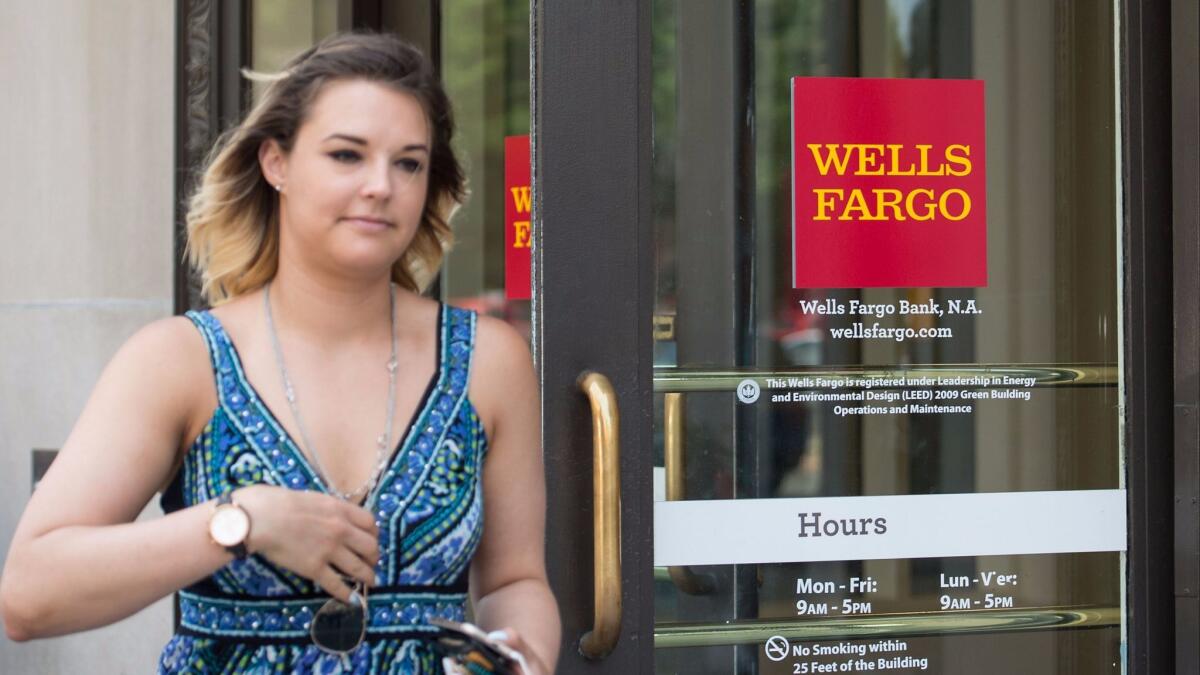With business still reeling, Wells Fargo plans more cost cutting and digital initiatives

Wells Fargo & Co. laid out plans Thursday for $2 billion in fresh cost cuts and a greater focus on digital banking — including on the Facebook Messenger platform — as it tries to attract new customers following its accounts scandal.
Speaking to investment analysts gathered at the bank’s investor day conference in San Francisco, executives announced an array of cuts, including the closure of 450 branches by the end of 2018 — 50 more than the bank had announced earlier this year. There is the potential for more closures in 2019.
Many U.S. banks have been closing branches in recent years as fewer customers visit and conduct more banking online and on their mobile phones.
Wells Fargo estimates its latest branch closures, back-office consolidation, automation and other moves should result in $4 billion in annual cost cuts, twice as much as previously announced.
The bank is making these and other moves “to better navigate through a changing landscape,” said Chief Executive Timothy Sloan, speaking at the event at a Four Seasons hotel blocks from the bank’s headquarters.
The bank’s expenses have climbed recently, driven in part by hiring more workers and increasing pay, as well as costs related to the accounts scandal. That’s taken a toll on the bottom line. The bank last month reported a revenue decline and flat net income in its first-quarter earnings report.
Chief Financial Officer John Shrewsberry told investors earlier this year that the bank is spending about $80 million every quarter on consultants, attorneys and other outside service providers for matters related to the scandal, in which employees opened as many as 2.1 million unauthorized customer accounts.
Those practices, first uncovered by a 2013 Los Angeles Times investigation, led to a $185-million settlement with regulators last September.
The bank has also paid more than $3 million in refunds to customers and has agreed to pay $142 million to settle a raft of class-action lawsuits. That deal is pending court approval, and there are other potentially costly lawsuits at earlier stages of litigation.
The rate of new bank and credit card account openings has also fallen sharply since the settlement with regulators was announced. In slides for one of Thursday’s presentations, the bank acknowledged the scandal has hurt other parts of its business too.
Wells Fargo estimates that it made 3% fewer home, auto, higher-education and other consumer loans in the first quarter — a loss of more than $1 billion in potential loans.
As the bank works to regain customers’ trust, it is looking for ways to reach customers beyond branches, which have long been central to Wells Fargo’s business. They serve as conduits for sales of mortgages, credit cards and other products.
But the bank closed nearly 40 in the first quarter alone and has eliminated the sales goals that gave workers incentives to push credit cards and other products on customers — and that were blamed for leading to the account scandal.
The shift away from branches has prompted the increased focus on mobile and online tools.
In 2015, 75% of new Wells Fargo credit card accounts were opened through a branch and 12% were opened through its website. In this year’s first quarter, branch card openings were down to 50%, while openings through the website were up to 22%.
What’s more, 8% of new card accounts in the first quarter were opened through websites other than Wells Fargo’s, such as creditcards.com. That’s up from 2% last year.
Bank executives are pursuing a handful of other digital initiatives too.
“It used to be, the only way to be convenient was to have a branch in a neighborhood,” said Avid Modjtabai, who leads Wells Fargo’s payments and innovation group. “Now it means us going to customers where they are — whether that’s in their car, on their watch, or on social media.”
The bank is targeting Facebook in particular. Last month, it started testing a chatbot — an automated tool that recognizes questions and offers answers — that customers can use to communicate with the bank on Facebook Messenger.
The goal is for the chatbot to be able to answer not only generic questions — such as the location of the nearest Wells Fargo ATM — but also detailed inquiries about customers’ accounts and spending patterns.
“We can provide them with very specific information about their accounts,” Modjtabai said. “When is my next credit card payment due? How much did I spend on groceries last month? How about three months ago?”
Other banks and financial services firms, including Bank of America and MasterCard, are also connecting with customers through Messenger chatbots.
The bank also is testing online applications for brokerage accounts and within the next few weeks will roll out a checking account that customers can open from a smartphone. Modjtabai said customers will be able to start using those accounts within five minutes, using a photo of their driver’s license for identity verification.
Another initiative, detailed by Franklin Codel, the bank’s senior vice president for consumer lending, aims to make the bank’s mortgage application process more competitive with those of private lenders such as QuickenLoans and LoanDepot.
The bank is rolling out an online and mobile mortgage application process that will pull borrowers’ information from the bank’s own system and from outside data providers so that customers have to submit fewer documents themselves, speeding up the process.
Codel said that’s a big deal, as many potential home buyers wind up getting a mortgage from whichever lender provides the first pre-approval.
Shares of Wells Fargo closed down 2%, or 98 cents, to $53.74.
Follow me: @jrkoren
UPDATES:
2:50 p.m.: This article was updated with a comment from Wells Fargo CEO Timothy Sloan, additional information on the bank’s online and mobile initiatives and details about how its accounts scandal has affected business.
This article was originally published at 11 a.m.
More to Read
Inside the business of entertainment
The Wide Shot brings you news, analysis and insights on everything from streaming wars to production — and what it all means for the future.
You may occasionally receive promotional content from the Los Angeles Times.











